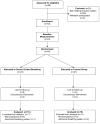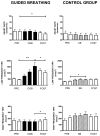Device-guided slow-breathing effects on end-tidal CO(2) and heart-rate variability
- PMID: 20183539
- PMCID: PMC4054864
- DOI: 10.1080/13548500903322791
Device-guided slow-breathing effects on end-tidal CO(2) and heart-rate variability
Abstract
Previous studies have reported that regular practice of a device-guided slow-breathing (DGB) exercise decreases resting blood pressure (BP) in hypertensive patients. The performance of DGB is associated with acute decreases in sympathetic vascular tone, and it has been suggested that the decreases in resting BP produced by regular practice of DGB over periods of weeks are due to chronic decreases in sympathetic nervous system activity. However, the kidneys respond to sympathetically mediated changes in BP by readjusting blood volume levels within a few days. Thus, the mechanism by which DGB could produce long-term BP changes remains to be clarified. Previous research with laboratory animals and human subjects has shown that slow, shallow breathing that increases pCO(2) potentiates BP sensitivity to high sodium intake. These findings raise the possibility that deeper breathing during DGB that decreases BP might involve opposite changes in pCO(2). The present study tested the hypothesis that performance of DGB acutely decreases a marker of pCO(2), end-tidal CO(2) (PetCO(2)). Breathing rate, tidal volume, and PetCO(2) were monitored before, during, and after a 15-min session of DGB by patients with elevated BP. BP, heart rate, and heart-rate variability (HRV) were also measured under these conditions. A control group was also studied before, during, and after a 15-min session of spontaneous breathing (SB). The DGB group, but not the SB group, showed progressive and substantial increases in tidal volume and low-frequency HRV and decreases in PetCO(2) and systolic BP. The PetCO(2) effects persisted into the posttask, rest period. The findings are consistent with the hypothesis that habitual changes in breathing patterns of the kind observed during DGB could potentiate an antihypertensive adaptation via effects on pCO(2) and its role in cardiovascular homeostasis.
Figures





Similar articles
-
Regular slow-breathing exercise effects on blood pressure and breathing patterns at rest.J Hum Hypertens. 2010 Dec;24(12):807-13. doi: 10.1038/jhh.2010.18. Epub 2010 Mar 4. J Hum Hypertens. 2010. PMID: 20200548 Clinical Trial.
-
Eight weeks of device-guided slow breathing decreases sympathetic nervous reactivity to stress in posttraumatic stress disorder.Am J Physiol Regul Integr Comp Physiol. 2020 Oct 1;319(4):R466-R475. doi: 10.1152/ajpregu.00079.2020. Epub 2020 Aug 26. Am J Physiol Regul Integr Comp Physiol. 2020. PMID: 32847397 Free PMC article. Clinical Trial.
-
Acute effects of device-guided slow breathing on sympathetic nerve activity and baroreflex sensitivity in posttraumatic stress disorder.Am J Physiol Heart Circ Physiol. 2018 Jul 1;315(1):H141-H149. doi: 10.1152/ajpheart.00098.2018. Epub 2018 Apr 13. Am J Physiol Heart Circ Physiol. 2018. PMID: 29652544 Free PMC article. Clinical Trial.
-
Exploring mechanisms of blood pressure regulation in response to device-guided and non-device-guided slow breathing: A mini review.Auton Neurosci. 2023 Jan;244:103050. doi: 10.1016/j.autneu.2022.103050. Epub 2022 Nov 14. Auton Neurosci. 2023. PMID: 36410208 Review.
-
Device-Guided Breathing for Hypertension: a Summary Evidence Review.Curr Hypertens Rep. 2016 Apr;18(4):33. doi: 10.1007/s11906-016-0631-z. Curr Hypertens Rep. 2016. PMID: 27059041 Review.
Cited by
-
Training of paced breathing at 0.1 Hz improves CO2 homeostasis and relaxation during a paced breathing task.PLoS One. 2019 Jun 20;14(6):e0218550. doi: 10.1371/journal.pone.0218550. eCollection 2019. PLoS One. 2019. PMID: 31220170 Free PMC article.
-
A Randomized Controlled Trial of Device Guided, Slow-Paced Respiration in Women with Overactive Bladder Syndrome.J Urol. 2019 Oct;202(4):787-794. doi: 10.1097/JU.0000000000000328. Epub 2019 Sep 6. J Urol. 2019. PMID: 31075059 Free PMC article. Clinical Trial.
-
An Anti-hyperventilation Instruction Decreases the Drop in End-tidal CO2 and Symptoms of Hyperventilation During Breathing at 0.1 Hz.Appl Psychophysiol Biofeedback. 2019 Sep;44(3):247-256. doi: 10.1007/s10484-019-09438-y. Appl Psychophysiol Biofeedback. 2019. PMID: 31065914 Free PMC article.
-
Slow Breathing Can Be Operantly Conditioned in the Rat and May Reduce Sensitivity to Experimental Stressors.Front Physiol. 2017 Oct 30;8:854. doi: 10.3389/fphys.2017.00854. eCollection 2017. Front Physiol. 2017. PMID: 29163199 Free PMC article.
-
Cerebral Hemodynamics and Vagally Mediated HRV Associated with High- and Low-frequency Yoga Breathing: An Exploratory, Randomized, Crossover Study.Int J Yoga. 2024 Jan-Apr;17(1):29-36. doi: 10.4103/ijoy.ijoy_197_23. Epub 2024 May 13. Int J Yoga. 2024. PMID: 38899140 Free PMC article.
References
-
- Anderson DE, Austin J, Coyle K. Hemodynamic and metabolic effects of inhibitory breathing. Homeostasis. 1993;34:328–337.
-
- Anderson DE, Fedorova OV, French AW. Preavoidance hypercapnia and decreased hematocrit in micropigs. Physiology and Behavior. 1996;59:857–861. - PubMed
-
- Anderson DE, Fedorova OV, Morrell CH, Longo DL, Kashkin VA, Metzler JD, Bagrov AY, Lakatta EG. Endogenous sodium pump inhibitors and age-associated increases in salt sensitivity of blood pressure in normotensives. American Journal of Physiology: Regulative, Integrative, and Comparative Physiology. 2008;294:R1248–1254. - PMC - PubMed
Publication types
MeSH terms
Substances
Grants and funding
LinkOut - more resources
Full Text Sources
